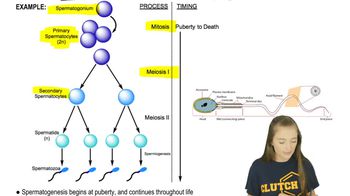Many frogs and mice are similar in size, yet a frog egg is vastly larger than a mouse egg. Propose a plausible explanation for this difference in the egg size.
Table of contents
- 1. Introduction to Biology2h 42m
- 2. Chemistry3h 40m
- 3. Water1h 26m
- 4. Biomolecules2h 23m
- 5. Cell Components2h 26m
- 6. The Membrane2h 31m
- 7. Energy and Metabolism2h 0m
- 8. Respiration2h 40m
- 9. Photosynthesis2h 49m
- 10. Cell Signaling59m
- 11. Cell Division2h 47m
- 12. Meiosis2h 0m
- 13. Mendelian Genetics4h 44m
- Introduction to Mendel's Experiments7m
- Genotype vs. Phenotype17m
- Punnett Squares13m
- Mendel's Experiments26m
- Mendel's Laws18m
- Monohybrid Crosses19m
- Test Crosses14m
- Dihybrid Crosses20m
- Punnett Square Probability26m
- Incomplete Dominance vs. Codominance20m
- Epistasis7m
- Non-Mendelian Genetics12m
- Pedigrees6m
- Autosomal Inheritance21m
- Sex-Linked Inheritance43m
- X-Inactivation9m
- 14. DNA Synthesis2h 27m
- 15. Gene Expression3h 20m
- 16. Regulation of Expression3h 31m
- Introduction to Regulation of Gene Expression13m
- Prokaryotic Gene Regulation via Operons27m
- The Lac Operon21m
- Glucose's Impact on Lac Operon25m
- The Trp Operon20m
- Review of the Lac Operon & Trp Operon11m
- Introduction to Eukaryotic Gene Regulation9m
- Eukaryotic Chromatin Modifications16m
- Eukaryotic Transcriptional Control22m
- Eukaryotic Post-Transcriptional Regulation28m
- Eukaryotic Post-Translational Regulation13m
- 17. Viruses37m
- 18. Biotechnology2h 58m
- 19. Genomics17m
- 20. Development1h 5m
- 21. Evolution3h 1m
- 22. Evolution of Populations3h 53m
- 23. Speciation1h 37m
- 24. History of Life on Earth2h 6m
- 25. Phylogeny2h 31m
- 26. Prokaryotes4h 59m
- 27. Protists1h 12m
- 28. Plants1h 22m
- 29. Fungi36m
- 30. Overview of Animals34m
- 31. Invertebrates1h 2m
- 32. Vertebrates50m
- 33. Plant Anatomy1h 3m
- 34. Vascular Plant Transport1h 2m
- 35. Soil37m
- 36. Plant Reproduction47m
- 37. Plant Sensation and Response1h 9m
- 38. Animal Form and Function1h 19m
- 39. Digestive System1h 10m
- 40. Circulatory System1h 49m
- 41. Immune System1h 12m
- 42. Osmoregulation and Excretion50m
- 43. Endocrine System1h 4m
- 44. Animal Reproduction1h 2m
- 45. Nervous System1h 55m
- 46. Sensory Systems46m
- 47. Muscle Systems23m
- 48. Ecology3h 11m
- Introduction to Ecology20m
- Biogeography14m
- Earth's Climate Patterns50m
- Introduction to Terrestrial Biomes10m
- Terrestrial Biomes: Near Equator13m
- Terrestrial Biomes: Temperate Regions10m
- Terrestrial Biomes: Northern Regions15m
- Introduction to Aquatic Biomes27m
- Freshwater Aquatic Biomes14m
- Marine Aquatic Biomes13m
- 49. Animal Behavior28m
- 50. Population Ecology3h 41m
- Introduction to Population Ecology28m
- Population Sampling Methods23m
- Life History12m
- Population Demography17m
- Factors Limiting Population Growth14m
- Introduction to Population Growth Models22m
- Linear Population Growth6m
- Exponential Population Growth29m
- Logistic Population Growth32m
- r/K Selection10m
- The Human Population22m
- 51. Community Ecology2h 46m
- Introduction to Community Ecology2m
- Introduction to Community Interactions9m
- Community Interactions: Competition (-/-)38m
- Community Interactions: Exploitation (+/-)23m
- Community Interactions: Mutualism (+/+) & Commensalism (+/0)9m
- Community Structure35m
- Community Dynamics26m
- Geographic Impact on Communities21m
- 52. Ecosystems2h 36m
- 53. Conservation Biology24m
44. Animal Reproduction
Animal Reproduction
Problem 8
Textbook Question
Which statement about human reproduction is true?
a. Fertilization occurs in the vagina.
b. Spermatogenesis and oogenesis both require normal body temperature.
c. An oocyte completes meiosis after a sperm penetrates it.
d. The earliest stages of spermatogenesis occur closest to the lumen of the seminiferous tubules.
 Verified step by step guidance
Verified step by step guidance1
Understand the process of fertilization in human reproduction. Fertilization typically occurs in the fallopian tubes, not the vagina, so statement (A) is incorrect.
Review the conditions required for spermatogenesis and oogenesis. Spermatogenesis occurs optimally at a temperature slightly lower than normal body temperature, while oogenesis occurs at normal body temperature, making statement (B) incorrect.
Examine the process of meiosis in oocytes. An oocyte completes meiosis II only after a sperm penetrates it, which supports statement (C) as true.
Consider the structure of seminiferous tubules in the testes. The earliest stages of spermatogenesis occur in the outermost layer of the seminiferous tubules, not closest to the lumen, making statement (D) incorrect.
Based on the analysis of each statement, identify which statement accurately describes a true aspect of human reproduction.
 Verified video answer for a similar problem:
Verified video answer for a similar problem:This video solution was recommended by our tutors as helpful for the problem above
Video duration:
1mPlay a video:
Was this helpful?
Key Concepts
Here are the essential concepts you must grasp in order to answer the question correctly.
Fertilization Process
Fertilization in humans typically occurs in the fallopian tubes, not the vagina. After ovulation, the oocyte is released into the fallopian tube, where it may encounter sperm. If a sperm successfully penetrates the oocyte, fertilization occurs, leading to the formation of a zygote, which then travels to the uterus for implantation.
Recommended video:
Guided course

1) RNA Processing
Meiosis in Oogenesis
Oogenesis is the process of egg cell formation, involving meiosis. An oocyte is arrested in metaphase II of meiosis until fertilization. Upon penetration by a sperm, the oocyte completes meiosis, resulting in a mature ovum and a second polar body, which is crucial for successful fertilization and subsequent embryonic development.
Recommended video:
Guided course

Oogenesis
Spermatogenesis
Spermatogenesis is the process of sperm cell development, occurring in the seminiferous tubules of the testes. It begins with spermatogonia located at the periphery of the tubules and progresses towards the lumen. The earliest stages of spermatogenesis occur at the outer edge, not closest to the lumen, and require a temperature slightly lower than normal body temperature, facilitated by the scrotum.
Recommended video:
Guided course

Spermatogenesis

 5:44m
5:44mWatch next
Master Sexual and Asexual Reproduction with a bite sized video explanation from Jason
Start learningRelated Videos
Related Practice
Textbook Question
779
views
